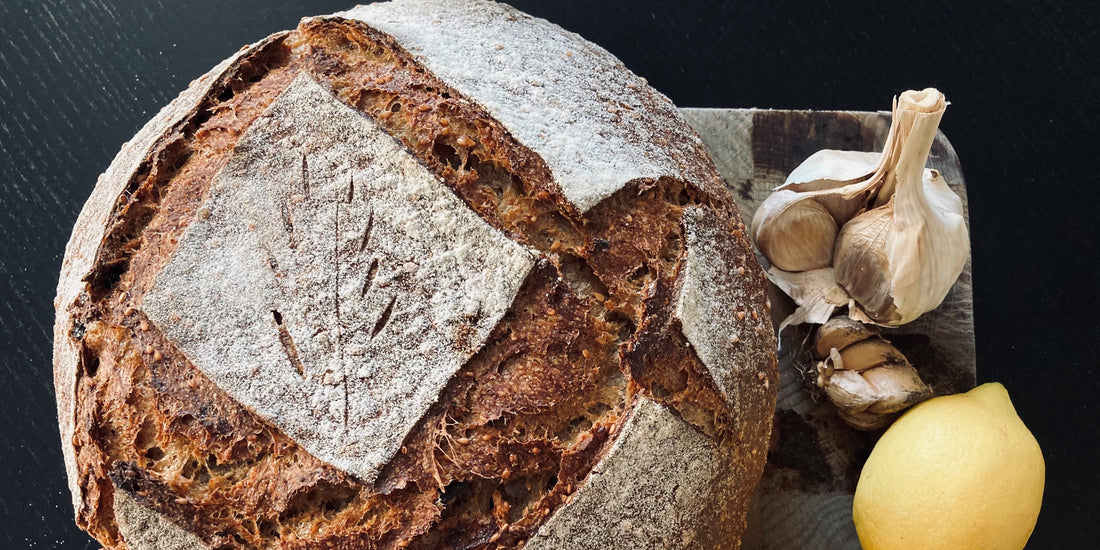
Sesame bread with fermented garlic
Share
|
Ingredients : Graham flour, wheat flour, rye flour, strong wheat flour, water, salt, sesame oil, sesame seeds, a fermented garlic Tool: Dough tray, dough spatula, two rising baskets, slicing knife and cast iron pan |
Time consumption: Day 1. Sourdough is refreshed. 5 minutes Day 2. Dough is mixed, folded and raised. 11 hours Day 3. Baked. 45 min. |

A few days ago I was out for a walk in my old hood in Nørrebro. It was as if the world was opening gently, unfolding, tentatively sticking a toe out to see if it would really fit, that you could actually BE OUT THERE. Young leaves on the trees, incredibly well-dressed people with equally well-dressed toddlers (how do people keep their kids from getting dirty and snot streaked across their cheeks??) strolling around, hanging out and buying food and designer items in the little shops , whose owners looked missing from their snail shells - "Is it really true? Is it CUSTOMERS coming through the door?” And to my own astonishment, I got caught up in the mood and wanted to buy everything. Nice cups, scarves that I don't need, books that I always need – and of course delicacies in long rows. I managed to stop myself before I put a diminutive can of herbes de Provence for just under 100 dasks in the basket (I usually buy a bag with three or four times as much in it for one and a half euros in Paris). But two things I couldn't resist: a few fermented garlic cloves and an insanely tasty Greek forest honey. The honey gets to play first violin for another good time. This time it will be about the garlic, which I had never tasted but had come across several times in my endless inspiration tours on the internet.
And yes, it strikes me as an expensive ingredient. But then, even when you buy the best organic flour and the finest first wheat, a loaf of bread almost never ends up costing more than approx. a flat twenty, and mostly less. So if you treat yourself to a little extravagance every once in a while, there is still a long way up to a 50,000 kroner racing bike, or whatever other hobby equipment people throw at it, right? And it makes good sense that the fermented – also called black – garlic is peppery, because it takes around a month to produce it. The garlic is long-baked at a constant, low temperature and precise humidity for a few weeks and then gently dried. The result is butter-soft, coke-black fat that nestles in its shells, just waiting to kick your taste buds. The taste is unlike anything else I've tried. Sweet, something like a mixture of balsamic vinegar and soy - just without the saltiness. It is PURE umami. I pondered quite a bit about what it should be accompanied by and which types of grain I wanted to bake it with. And so I landed on a lot of the good, mild wheat in different degrees of milling, a bit of rye to give character to the crumb, and then both sesame seeds and sesame oil to add extra kick to the umami feast.
It's not a difficult bread to bake, because the ingredients don't have to be folded in or anything, just mixed into the dough at the start. But if you are a little uncertain about shaping and/or think it is a hassle with the cast iron pan, you can just plop the dough into two small molds and bake them at 220 degrees for approx. 40 minutes - in that case remember to throw a small cup of water in the bottom of the oven at the same time as putting the loaves in.
Bon appetit!
Tool:
Metal dough spatula and/or plastic dough scraper, two rising baskets lined with tea towels, sharp knife or razor blade and cast iron pan
Ingredients:
- 200 g graham flour
- 200 g of wheat l
- 50 g rye flour
- 550 g strong wheat flour, e.g. Type xx
- Approx. 200 g refreshed sourdough
- 750 g lukewarm water + approx. 50 g of water together with the salt, possibly a little more under the folds
- 24 g of salt
- 20 g sesame oil
- 100 g toasted, unshelled sesame seeds (be careful not to toast the seeds too hard or they will become bitter)
- A whole fermented garlic (available, among other things, in Camilla Plums Landhandel in Jægersborggade and in certain well-stocked Irma stores)
- Rice flour for dusting the tea towels
Course of action:
Day 1 , evening: refresh your sourdough
Day 2 , morning:
- The types of flour are mixed well in a large milk dish or similar, and water and sourdough are added and mixed to form an uneven porridge - make sure, however, that all the flour is wet.
- Let the dough rest for approx. ½ hour.
- The salt, sesame seeds and oil, the sliced garlic cloves and the last water are added and worked well into the dough.
- Over the next few hours, the dough is gently stretched and folded 3-4 times, as Michael shows so beautifully in Rugkop's online baking course (video below). Be a little extra careful because of the sesame seeds, which can easily destroy the gluten structure if you take too hard. In any case, the crumb in the bread will probably not be very open (i.e. with very large holes), but it should preferably feel reasonably airy.
- When the dough has risen by approx. 20-30%, you can sip a small pinch and put it in a glass of water: if it floats on top, it is ready to be shaped and lifted.
- Divide the dough in half, gently shape them into balls by pulling them around and towards you using a metal dough scraper. The high liquid content and the rye flour make the dough a little sticky - it can help to rinse your hands and dough scraper in very cold water right before.
- Let the dough balls rest for approx. 10 min before they get their final round or oblong shape as desired. The "envelope method" is a sure winner - check out Michael's sure hand below.
- Leave the two doughs on the kitchen counter to recover a bit before putting them in the fridge until late in the evening or the next day.*
Day 2 , evening or day 3 morning (see note below):
- Place a cast iron pan in the oven, which is heated to approx. 250 degrees. It takes a good half an hour, for some ovens a whole hour, to heat up properly.
- Take a loaf of bread out of the fridge and turn it out into the lid of the pan, if this is flat/without a knob on top - otherwise you can turn the bread out onto a piece of baking paper and lift the bread into the pan by holding a few pieces of the paper.
- Cut the bread with a sharp knife or razor blade and put the lid on.
- The bread must first be baked with the lid on for 20 minutes. at 250 degrees and without a lid for 25-30 min. at 220 degrees. Remember to heat the oven and pot again before putting bread no. 2 in.
*This is a tricky point: my kitchen is hot, and it's only getting worse as spring progresses and turns into full-on summer. In addition, the wonderful, freshly ground flour from Kragegaarden is extremely active. So I actually often have to shorten the proofing process enormously and bake the loaves already late the same evening, even if they proof in the fridge. Sometimes I can buy myself some time by halving the amount of sourdough and using cooler water. Try your hand and keep an eye on your dough instead of following the times too closely. It takes time and quite a few tries, but it's well worth it. And there is great satisfaction in adapting one's baking to exactly one's own conditions and time frames - a bit like taming a wild animal (that is, not one of those that bite, more like a little cloud, a small one of the kind that only gives his best after persistent and patient courtship).
The dough is folded and stretched (Extracts from Rugkop's online baking course )
The envelope method: The dough is shaped like an envelope (Excerpt from Rugkop's online baking course )
Anyone can learn to bake light sourdough bread. Buy our online course and get flour and equipment delivered to your door.
